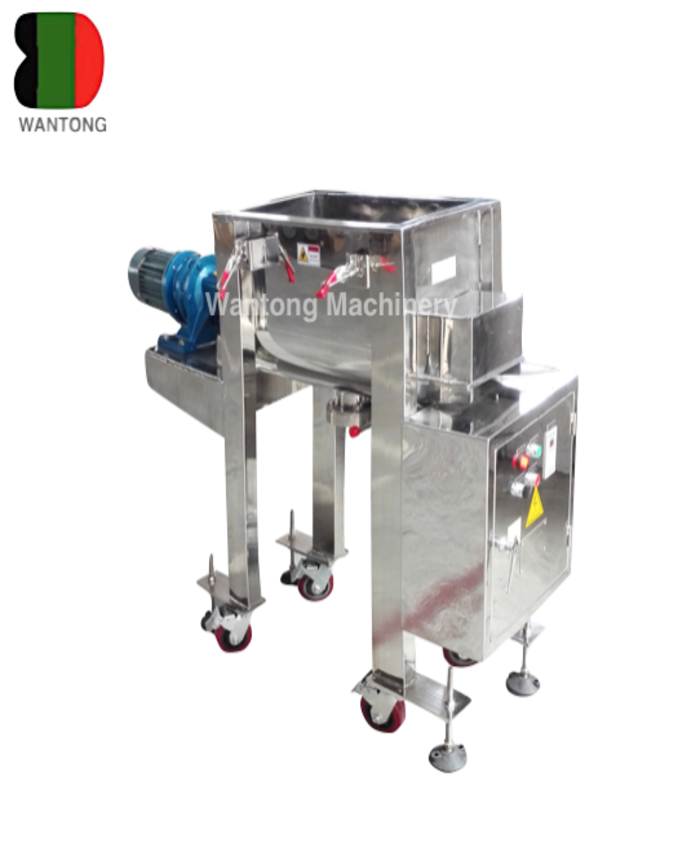Home > Company News > Mixing principle and advantages of the mixer
-
 Raisha Wang
Welcome to my shop, I'm glad to serve you. Please feel free to send me any questions you may have.
Raisha Wang
Welcome to my shop, I'm glad to serve you. Please feel free to send me any questions you may have.
Your message has exceeded the limit.
Company News

Today, the Powder Mixer Mixing Machine will introduce the mixing principle and advantages and disadvantages of the mixer.
1 Horizontal Ribbon Mixer
Horizontal endless belt mixer is mainly composed of body, screw shaft, transmission part and control part. The body is slot-shaped, and its cross-section has three types: 0-shaped, U-shaped and w-shaped. Among them, U-type mixers are most commonly used. In the U-type mixer, the single-shaft double-helix is the most common. The inner and outer spirals of the machine are left and right spirals, so that the materials are fully mixed in the mixer according to the countercurrent principle. Spiral blades on the outer ring make the material flow in one direction along the axis of the spiral, and spirals on the inner ring make the material flow in the opposite direction, so that the material moves from one place to another in a pile, and quickly reaches a rough mass Based on this, there are more surfaces to carry out detailed and inter-particle mixing, so as to achieve uniform mixing. The mixing time is generally 3 minutes per batch, usually between 2-6 minutes, so 10 batches of material can be mixed per hour. The advantages of the horizontal endless belt mixer are high mixing efficiency, good mixing quality, short unloading time, and low residue, so it is currently widely used in feed plants.

Horizontal Ribbon Mixer
2 vertical mixer
The vertical mixer is mainly composed of a receiving hopper, a vertical stirrer, a casing, a discharge valve, a bracket and a motor drive. The vertical mixer achieves mixing by dispersing the materials with a vertical auger. Because it is mainly mixed by the diffusion principle, the mixing time is longer. Generally, the mixing time of a batch of feed is 15-20min. The advantage of the vertical mixer is that the supporting power is small and the occupied area is small. It can be used with other equipment or alone.
3 Twin shaft paddle mixer
The twin-shaft paddle mixer is mainly composed of a body, a rotor, a discharge mechanism, a transmission part and a control part. The machine body is double-slot-shaped, and its cross-sectional shape is w-shaped. There are two feed openings at the top of the machine body, and one discharge opening at the bottom of the two machine slots. The rotor of the machine is composed of two shafts installed side by side and rotating opposite to each other, and a paddle mounted on the shaft. Each set of blades has two blades, which are generally mounted on the shaft at an angle of 45. The blade groups on the two shafts are staggered from each other, and the wheelbase is smaller than the sum of the lengths of the two blades. When the rotor is running, the corresponding blade ends on the two shafts overlap and overlap in the central part of the body, but they will not collide with each other. When the mixer is working, the materials in the machine present a multi-directional composite motion state:
One is convection mixing along the rotor axis;
The second is shear mixing, that is, due to the velocity gradient distribution in the materials, shear surfaces are formed in the materials, causing collisions and sliding between the materials, thereby forming shear mixing;
The third is a special diffusion mixing. In the middle line of the body, the motion overlap area formed by the two rotors rotating in opposite directions. Due to the opposite movement of the two rotors, the material in this area is twice as strong as the rotating blades in other areas. the above. Its characteristics are light and peaceful mixing, low friction, no segregation of the mixture, and will not destroy the original physical state of the material. This mixer is mainly used for the addition of molasses and the mixing of minerals and trace elements with high mixing uniformity.
4 Conical planetary mixer
The conical planetary mixer is mainly composed of a casing, a spiral working part, a crank, a revolution and rotation motor, and a transmission. When the crank rotates, through the transmission of the crank and the gear, the screw shaft revolves around the conical cylinder and rotates at the same time, so that the materials are not only mixed up and down, but also continuously rotated around the simplified Chinese and mixed horizontally. Because the shell is tapered, the upper and lower parts move at different speeds, and the movement speeds at the same level are different, so that there is relative movement between the materials. Therefore, the mixer is mainly diffusion mixing when working, and the mixing effect is strong, the mixing time is short, and the final mixing quality is better. In addition, the particle size, density, scattering of the mixture and the filling factor of the material in the mixing cylinder will not significantly affect the normal operation of the mixer. Its advantages are strong mixing effect, short mixing time, statistically complete mixing state can be reached quickly, and the residual amount is small, which is more suitable for the processing of pre-mixed feed.
5 v Type Mixer
V-type mixer is one of the representative models of rotary drum mixer. The material rotates with the barrel. The movement trajectory in the barrel is an approximately elliptical trajectory where the two symmetrically intersect. The materials are separated and aggregated alternately and repeatedly in the machine.
-
Raymond Mill Supplier in Indonesia
-
Raymond Mill Maintenance Guide
-
Top 10 Industrial Pulverizer Manufacturers
-
How to Choose a Raymond Mill Supplier
-
High-Performance Gypsum Grinding Machine
-
Raymond Mill for Calcium Carbonate Powder
-
Cost-Effective Ore Processing
-
Energy-Efficient Mining Machinery
-
Low-Noise Grinding Equipment
-
Eco-Friendly Industrial Mills
-
Sustainable Mineral Processing
-
Turnkey Powder Production Line

